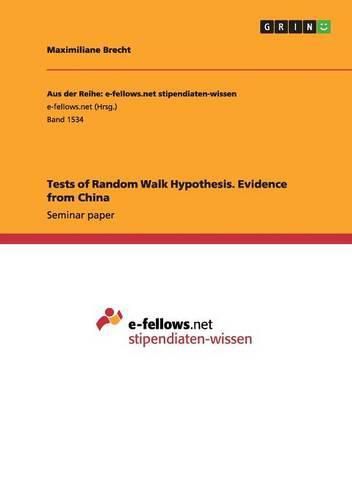Readings Newsletter
Become a Readings Member to make your shopping experience even easier.
Sign in or sign up for free!
You’re not far away from qualifying for FREE standard shipping within Australia
You’ve qualified for FREE standard shipping within Australia
The cart is loading…






Seminar paper from the year 2015 in the subject Economics - Finance, grade: 1.0, course: Research Methodology and Dissertation, language: English, abstract: Until the 1970s empirical studies generally supported the prediction following from weak-form efficiency: prices cannot be predicted using past prices, and returns are serially uncorrelated. However inter alia Shiller, Fischer, and Friedman (1984) refuted the conclusion of economic insignificance in the case of negligible autocorrelations by modeling return processes with irrational bubbles where short-horizon returns are not significantly autocorrelated. Empirically, studies such as Lo and MacKinlay (1988) reject the random walk hypothesis (RWH) for US stocks using the more powerful variance ratio (VR) test. Similarly, RWH has also been tested for other markets with varying results. This report aims to examine the Chinese stock market as it stands out insofar that it is segmented by investor type 3 that face identical conditions otherwise. It also allows to observe consequences of loosening capital controls in terms of return-predictability. Empirical evidence so far has produced mixed results: for instance Long, Payne, and Feng (1999) do not find significant autocorrelation using a 100-week sample. On the other hand, Su and Fleisher (1999) reject the RWH when using daily data and for the market for foreign investors when using weekly data. Similarly, Darrat and Zhong (2000) find positive autocorrelation in the composite index using weekly data. Using daily data until 2000, the RWH is rejected again only for the market for foreigners, but not for locals. This work will build on empirical studies such as Long, Payne, and Feng (1999), concentrate on the VR test, and include observations following a policy reform in 2011 to test inter alia the hypothesis whether the market for foreigners became more efficient.
$9.00 standard shipping within Australia
FREE standard shipping within Australia for orders over $100.00
Express & International shipping calculated at checkout
Seminar paper from the year 2015 in the subject Economics - Finance, grade: 1.0, course: Research Methodology and Dissertation, language: English, abstract: Until the 1970s empirical studies generally supported the prediction following from weak-form efficiency: prices cannot be predicted using past prices, and returns are serially uncorrelated. However inter alia Shiller, Fischer, and Friedman (1984) refuted the conclusion of economic insignificance in the case of negligible autocorrelations by modeling return processes with irrational bubbles where short-horizon returns are not significantly autocorrelated. Empirically, studies such as Lo and MacKinlay (1988) reject the random walk hypothesis (RWH) for US stocks using the more powerful variance ratio (VR) test. Similarly, RWH has also been tested for other markets with varying results. This report aims to examine the Chinese stock market as it stands out insofar that it is segmented by investor type 3 that face identical conditions otherwise. It also allows to observe consequences of loosening capital controls in terms of return-predictability. Empirical evidence so far has produced mixed results: for instance Long, Payne, and Feng (1999) do not find significant autocorrelation using a 100-week sample. On the other hand, Su and Fleisher (1999) reject the RWH when using daily data and for the market for foreign investors when using weekly data. Similarly, Darrat and Zhong (2000) find positive autocorrelation in the composite index using weekly data. Using daily data until 2000, the RWH is rejected again only for the market for foreigners, but not for locals. This work will build on empirical studies such as Long, Payne, and Feng (1999), concentrate on the VR test, and include observations following a policy reform in 2011 to test inter alia the hypothesis whether the market for foreigners became more efficient.